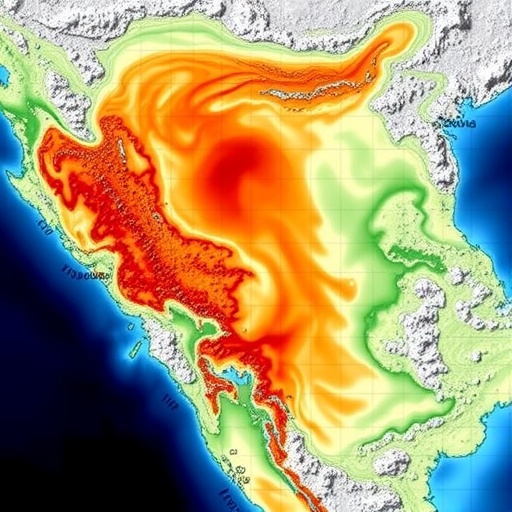In the depths of our planet’s oceans, a critical but elusive process unfolds—one that significantly impacts global climate systems through the regulation of nitrous oxide (N₂O), a potent greenhouse gas and ozone-depleting compound. Recent groundbreaking research conducted by scientists from the Max Planck Institute for Marine Microbiology in Bremen, Germany, has peeled back layers of mystery surrounding the turnover of N₂O in the Black Sea, a vast anoxic basin characterized by oxygen-deprived waters that stretch from approximately 150 meters to depths beyond 2000 meters. Their findings, published in Limnology and Oceanography, provide compelling evidence that challenges previous assumptions about the Black Sea’s role as a source of this climate-affecting gas.
Nitrous oxide presents a severe environmental challenge due to its high global warming potential—approximately 300 times that of carbon dioxide over a 100-year period—and its significant contribution to ozone layer depletion. Natural emissions predominantly emerge from oceanic sources where oxygen levels are severely diminished, creating unique biogeochemical conditions conducive to N₂O production. The Black Sea, the largest anoxic marine basin on Earth, offers a natural laboratory where such processes can be studied intensively, yet paradoxically, it appears to release surprisingly low quantities of N₂O into the atmosphere.
To unravel this paradox, lead author Jan von Arx and his colleagues embarked on an ambitious research expedition aboard the research vessel RV Poseidon. Utilizing a CTD rosette—a sophisticated oceanographic apparatus capable of measuring conductivity, temperature, depth, and collecting discrete water samples—the team targeted the Black Sea’s suboxic zone. This suboxic layer, situated between the oxygen-rich surface and the anoxic deep layers, harbors complex microbial communities that orchestrate the delicate balance between N₂O production and consumption.
Their investigations revealed a remarkable biological conundrum. Although multiple microbial pathways within the suboxic zone actively generate nitrous oxide, an even more critical process occurs simultaneously: the robust microbial reduction of N₂O back to dinitrogen gas (N₂), an inert molecule with no greenhouse effect. This reduction is predominantly mediated by specialized denitrifying bacteria equipped with nitrous oxide reductase enzymes, which enable them to act as biological sinks, effectively filtering out nitrous oxide before it can escape to the atmosphere.
The significance of this microbial filter extends beyond the Black Sea, offering a new perspective on the ocean’s role in regulating atmospheric N₂O levels. Previous models often overlooked or underestimated the importance of N₂O consumption, leading to gaps in understanding the global N₂O budget. By quantifying the dynamic interplay between production and reduction processes, this study underscores the Black Sea’s function not merely as a source but rather as a nuanced system where N₂O emissions are tightly controlled by microbial activity in low-oxygen zones.
Moreover, these findings carry profound implications in the context of accelerating climate change. As ocean temperatures rise and stratification intensifies, oxygen-depleted zones are expanding worldwide—a phenomenon known as ocean deoxygenation. This expansion poses a dual risk: while low oxygen levels stimulate increased microbial production of N₂O, the capacity of microbial communities to mitigate emissions through reduction might be compromised or altered. Understanding these complex responses is crucial for projecting future N₂O emissions and their feedback effects on global warming.
Technically, the study employed a series of incubation experiments coupled with molecular analyses such as metagenomics and metatranscriptomics to identify active microbial players and their functional genes involved in N₂O turnover. By integrating concentration measurements of N₂O and isotopic tracer techniques, the researchers could distinguish between production and consumption rates across depth profiles, providing an unprecedented resolution of biogeochemical processes in situ.
Importantly, the study also highlights a gap in our current knowledge regarding the oceanic nitrogen cycle. The globally integrated rates of N₂O reduction remain poorly characterized, limiting our predictive capabilities of how marine N₂O fluxes might respond under shifting environmental conditions. Bridging this knowledge gap necessitates expanded research efforts targeting diverse oxygen minimum zones and suboxic environments across the world’s oceans, embracing multidisciplinary approaches to capture the complexity of microbial-mediated transformations.
The exploration of the Black Sea’s suboxic zone thus exemplifies how fundamental microbiological and geochemical research can unveil critical regulatory mechanisms of climate-important gases. As anthropogenic pressures continue to alter marine environments, tracking how microbial ecosystems adapt or falter under these stressors becomes essential. Insights from these studies not only enrich our scientific understanding but also inform climate models and mitigation strategies aimed at curtailing greenhouse gas emissions from natural sources.
Furthermore, this research adds a new dimension to the narrative of ocean health and biogeochemical resilience. It underscores the ocean’s potential to act as both a source and sink of N₂O, mediated by the microbial community’s balance, rather than a straightforward emitter. The dualistic nature of these processes complicates policy approaches but, simultaneously, opens avenues for novel interventions, such as leveraging microbial pathways to enhance natural attenuation of potent greenhouse gases.
The pioneering work conducted by the Max Planck team charts a course forward—one grounded in the recognition that microbial life forms the foundation of Earth’s climate regulation. As they continue to investigate other oxygen-limited marine environments, the accumulation of comparative data will refine global biogeochemical models, providing a more comprehensive understanding of nitrous oxide dynamics on a planetary scale.
Finally, in the face of uncertain and rapidly shifting oceanic conditions, this study serves as a call to action for the scientific community and policymakers alike. Addressing the nitrous oxide conundrum is imperative for confronting climate change and preserving the delicate balance of Earth’s atmosphere. Only through robust, targeted research and cross-disciplinary collaboration can we hope to decipher and manage the intricate mechanisms governing greenhouse gas fluxes in our oceans.
Subject of Research:
Microbial processes regulating nitrous oxide production and consumption in the suboxic zone of the Black Sea.
Article Title:
Nitrous oxide turnover in the suboxic zone of the Black Sea
News Publication Date:
15-Aug-2025
Web References:
10.1002/lno.70182
Image Credits:
Jana Milucka / Max Planck Institute for Marine Microbiology
Keywords:
Nitrous oxide, greenhouse gas, Black Sea, suboxic zone, marine microbiology, ocean deoxygenation, N₂O reduction, denitrifying bacteria, biogeochemical cycling, climate change, oceanography




